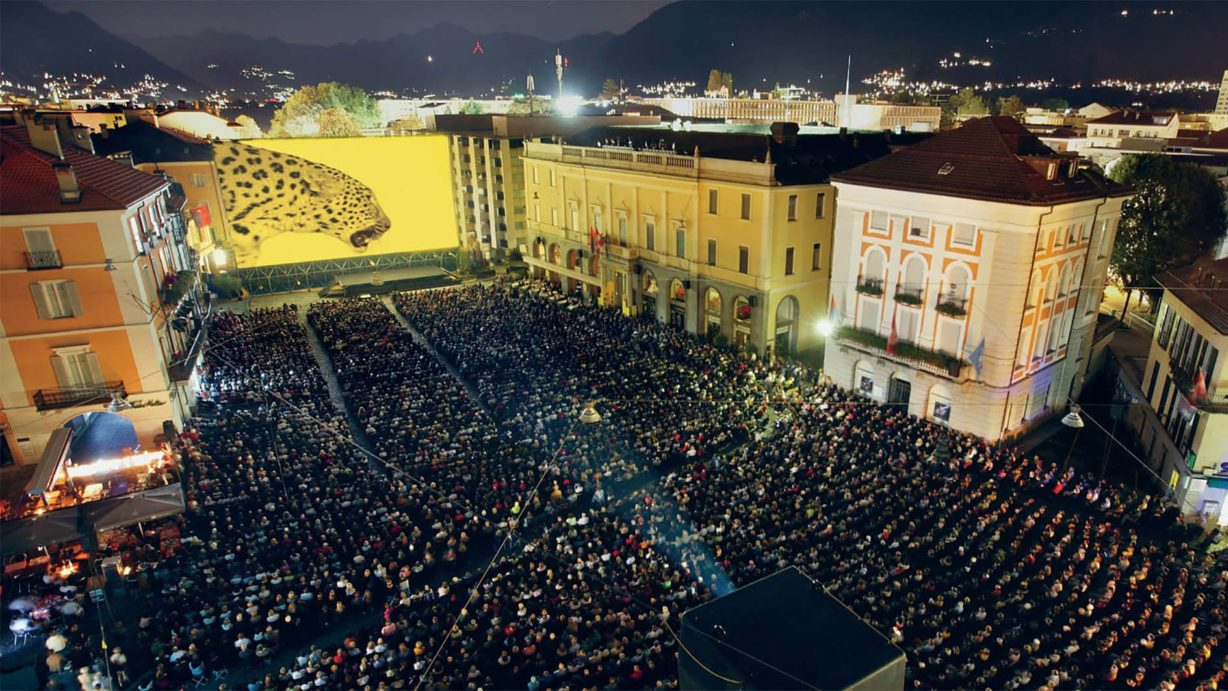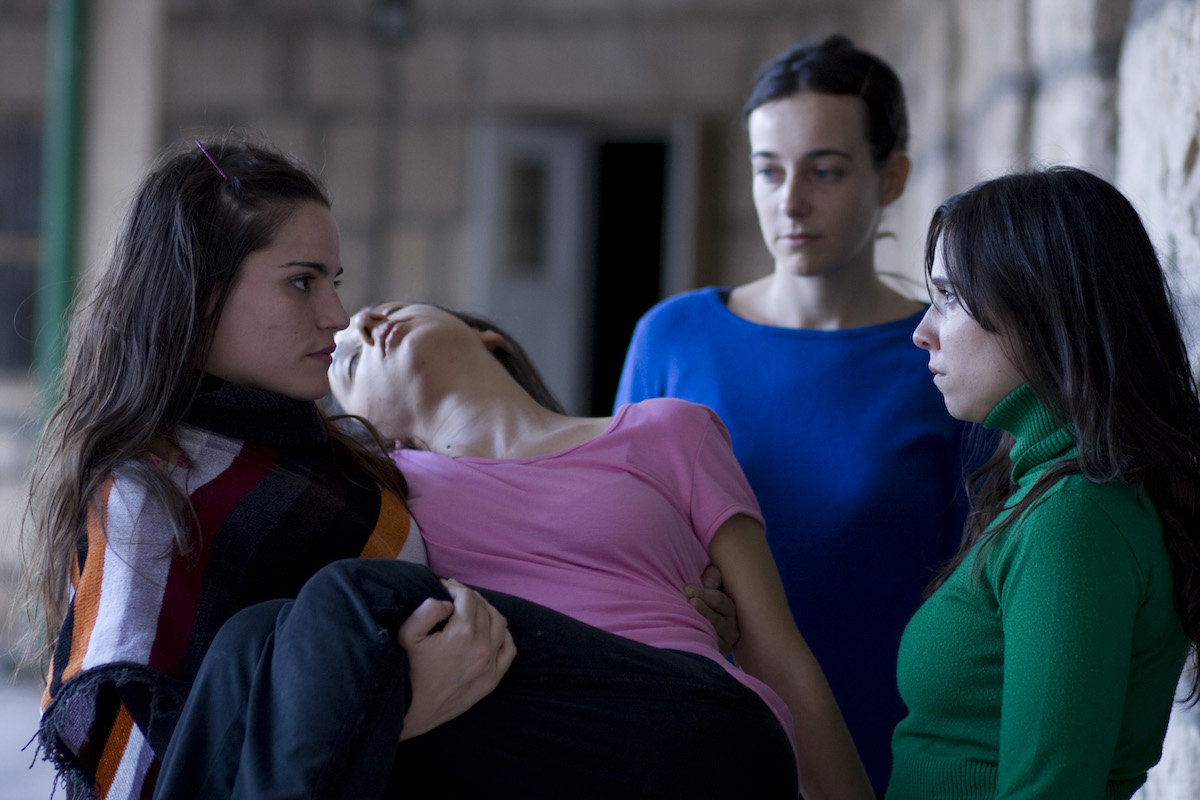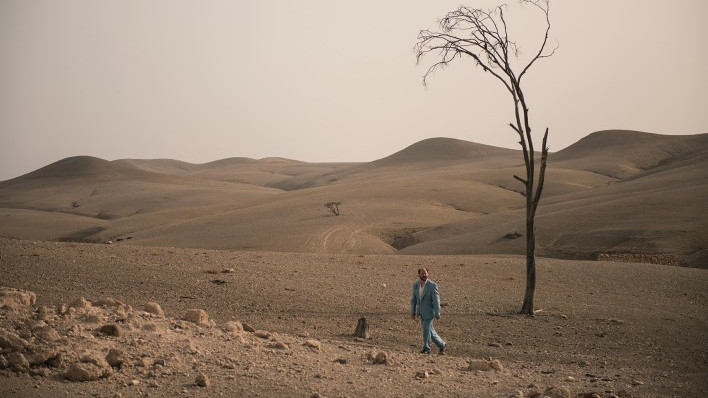New Experiments in Cinema: The 71st Locarno Film Festival
Skip other details (including permanent urls, DOI, citation information)
: This work is licensed under a Creative Commons Attribution-NonCommercial-NoDerivatives 4.0 International License. Please contact [email protected] to use this work in a way not covered by the license.
For more information, read Michigan Publishing's access and usage policy.

One of the longest running film festivals in the world, the venerable Swiss gathering in Locarno has ascended to a position as the go-to place for the latest thought-provoking, stylistically pioneering cinema. This year, the festival established a special sidebar, Signs of Life, a laboratory for intermingling cinema with works more suited to art galleries. The displacement from theaters allows some filmmakers to experiment with film language. Lorcarno incorporates contemporary avant-garde and abstract films; a progressive programming strategy permeates the entire festival.
My first example is Mariano Llinas’ latest endeavor, La flor, a gargantuan multi-genre para-anthology clocking in at 815 minutes. In a choice that a raised many eyebrows, the longest-running film in the history of the festival was chopped into smaller pieces (acts) over the course of the week, and later re-screened in larger structures (parts) of approximately 300 minutes each. The festival’s artistic director, Carlo Chatriani hailed the experiment as “a new way to watch films.” La flor subverts the concept of binge-watching with a story-hopscotching amalgam of Proustian dimensions.

Dominated by four actresses rotating in the leading and supporting roles, the metatextual multiverse gravitates more towards theorizing how fictional worlds are constructed, rather than towards the actual stories themselves. In a similar vein, the International Film Festival in Rotterdam screened Simulacrum Tremendum, a thirteen-hour autobiographical video archive of Philippine multi-hyphenate artist Khavn, who accompanied the whole screening by playing live piano.
In trying to pin down a pattern defining the 71st edition of the Locarno Film Festival, a couple of motifs stand out. Among the most significant are a series of coming-of-age pieces, the topic of first love, and most timely, women in front of and behind the camera.
The three strands converge idiosyncratically in a feature debut, A Family Submerged by the Argentinean actress-cum-filmmaker María Alché. Coping with her sister’s recent death while tidying the belongings she left behind, a middle-aged housewife and mother of three, Marcela descends into a grief-induced melancholy state of inertia. Even though Marcela displays the usual symptoms of a mid-life crisis and domestic burnout, the diagnosis is of a higher order, rising to the level of an existential emergency.
After Marcela meets a friend of her daughter, the writer-director prevents the story from devolving into coming-of-middle-age clichés. Alché avoids any depiction of physical contact or lust on screen, keeping the psychological dimension in the foreground. Alché uses Marcela’s state of detachment from her mundane life to depict a timeless space where memory and hallucinations veer toward nostalgia and madness.
The protagonist encounters her ancestors, trapped in an asylum of memories. Marcela walks the thin line dividing sanity from mental disorder, eventually transcending into a metaphysical plane. Alché pushes her protagonist through a wormhole of lost memories.
Cinematographer Héléne Louvart frames the characters from close angles, mostly in enclosed interior spaces, translating the protagonist’s feeling of suffocation in her own house. The similarly composed shots set in the other spaces of nostalgia and delirium, however, produce a more liberating effect. Shortsighted rationality is challenged by the protagonist’s inner turmoil. The minimalist psychological drama uses tightly controlled scenes of wistful fever dream to great effect. Alché’s low-key chamber drama manage to express a universal theme. The film revolves around loneliness, cured by an inter-generational continuum implying a cosmic oneness. As Marcela in her grief-stricken trance feels alienation, the strange reverie of her ancestors provides an otherworldly sense of wholeness, devoid of sentimentality.
Young Chinese filmmaker Qui Sheng engages in experimental storytelling techniques to push the envelope towards a cryptic and stream-of-consciousness format in his latest feature, poetically entitled, Suburban Birds. After a slow-burn opening about a wandering group of engineers and a land surveyor investigating a neighborhood in modern day China that had to be evacuated, Sheng steers the film off of the rails of linear plot. Even the expected main thread about an attempt to prevent a sinkhole catastrophe in the urban area soon dissipates into more introspective episodes of conviviality and insecurity. After the screening, the writer-director openly admitted being under the influence of Bohemian Jewish writer Franz Kafka, particularly his novel, The Castle (1926).
The camera follows the group of land surveyors on and off their job, an observation unearthing their personalities in a series of snapshots. A sudden narrative transition switches to a rag-tag group of kids seemingly unrelated to the initial adult characters. The film follows the children through their daily activities without a hint of explanation. The introduction of a new plotline with a different cast of characters prompts the audience seeking parallels that might bind the two completely different worlds.
Both groups share physical similarities, as if each adult had their child avatar, although that theory becomes discredited as all the characters appear in the same scene at once. Even if the side-by-side narratives are not echoes of past or future, a strong wave of nostalgia washes over the portion of the film featuring the children. Sheng eventually reveals his work as semi-autobiographic, full of childhood memories recalled and re-created. Even though the writer-director switches to a coming-of-age story, both plots inform each other. The narratives prove to be circular in nature, rather than parallel. The film creates repeating cycles of past, present and future to create an impressionistic and introspective style of storytelling that downplays plot.
Written and directed by Antoine Russbach, Ceux qui travaillent (Those Who Work) offers a tightly scripted, toned-down psychological drama. Russbach exclusively follows the protagonist, a successful middle-aged logistics manager named Frank, a man who provides his family with the comforts of the upper-middle class. His children take their lives for granted by virtue of being born into them. As the sole breadwinner, Frank has a demanding job. The conflict begins when he has to make a tough decision to save his company’s reputation.
Frank’s moral compass goes haywire; his twisted judgment results in an appalling and criminal act. The company severs ties with Frank immediately. Russbach’s film charts the downfall of a self-made man who rose from his early life as a poor peasant boy. The rest of the film deals with the fallout of Frank’s actions, placing him on a path of self-discovery. The film defies outdated male archetypes of a now bygone era. Those Who Work is a morality tale carefully nestled into a realist drama about capitalism. The camera never abandons the poker-faced protagonist, carefully mapping him.
The film offers a character study, critiquing the tyranny and corruption of free-market economics. Russbach emphasizes traditions and life priorities, returning to the family drama in the third act. Frank’s most innocent child joins him as he confronts the consequences of his transgression, and undergoes a self-transformation. Those Who Work is a subtle film; Russbach avoids big gestures and psychobabble, instead offering a one-character show, with its protagonist becoming more perceptive to his surroundings as the film progresses.
The macho stereotype emerging from local traditions is further investigated in Yona Rozenkier’s debut semi-autobiographical drama, The Dive. The newcomer wrote, directed and also stars as one of the film’s three brothers. The siblings reunite in their childhood kibbutz in northern Israel to dispose of their late father’s remains. According to the elder’s last wish, his severed hand is to be buried in an underwater cave by his progeny.
The homecoming soon turns bitter as the youngest has to enter into military service in Lebanon two days after the burial. His older siblings, who both have already tasted the battlefield, have come to different conclusions about the war. The youngest finds himself in a fraternal tug of war where past sins drive the plot, set against the backdrop of an actual military conflict where air raids are a daily routine.
Rozenkier’s film focuses on the male inhabitants of the kibbutz, exploring the relationship between masculinity and loyalty. The middle brother enjoys a warm welcome home, but is tainted by unarticulated accusations from his childhood friends. The desertion of one’s home town is regarded as breaking a code, patriotism being an inherent part of local identity as well as a badge of nationalism. Military service, being the ultimate honor and basic duty, poses as a rite of passage, forging the character of men whose lives are subsumed under such traditional views.
Rozenkier uses the figure of the absent father to establish an implicit allegory about Israel failing to fulfill its basic obligations to its citizens, while nonetheless imposing obligations on them. The writer-director composes his debut as a family dramedy, the vestiges of dark, absurd humor common to a recent wave of Jewish films. Even though The Dive does not present itself as outwardly political, the undertones of the geo-political setting linger, yet do not obstruct the story of the youngest brother, a player in an adrenaline-filled finale of sacrifice and atonement.
Masculinity and the shadow of colonialism feature prominently in another debut feature, this one by Hungarian filmmaker Bálint Kenyeres. Hier, the writer-director’s adventurous take on a mid-life crisis sees Victor Ganz, the owner of a civil engineering company, flying to Morocco to deal with problems at a construction site. Once in the foreign land, the protagonist begins pursuing a specter of his former lover as if entering a portal to his past. The ephemeral figure leads him to places from his memory.
The protagonist overcomes rough encounters in an exotic environment by sheer masochistic determination. Besides the former lover, another elusive figure turns out to be the boss of an arms-dealing mafia gangster. Hier turns into a high testosterone fantasy of a delirious and confused middle-age man. Kenyeres keeps the story cryptic enough to make it hard to distinguish fantasy from reality within the bounds of this slow-burning drama.
The desolate dunes, isolated ramshackle houses and ruins appear to hold more significant meaning rather than being emotionally stained landmarks pulled out of somebody’s unreliable memory. The film’s cinematographer is Ádám Fillenz, second unit camera operator on Blade Runner 2049 (2017), and camera operator for AMC’s new moody period horror series, The Terror. Fillenz puts the emphasis on space as he slowly dollies or pans the camera during the exterior shots, highlighting the crushing vastness of a visual vacuum.
Conversely, the protagonist is isolated in suffocating interior shots of mostly empty buildings. As Ganz navigates these labyrinthine spaces, his memory sprawls over the structures: Fillenz constructs a psycho-ethnographic map for his central character. Every memory is incomplete. Filling in the blanks requires confabulation rather than retrieval. The delusional state blends present and past. Kenyeres thoughtfully subverts Ganz’s self-imposed role of knight in shining armor, critiquing the white messiah savior cliché.
Hier uncoils as a slow-burning psycho-thriller influenced by David Lynch’s neo-noir, complete with that filmmaker’s interest in the psychosexual. Hier also leans toward an homage to Michelangelo Antonioni’s The Passenger. Due to the immersive lensing, Hier’s wandering through sites of memory coincidentally forms an analogous trajectory to María Alché’s A Submerged Family. Reminiscences gradually dissolve in a modern-day man’s waking fever dream, a twisted re-interpretation of Orpheus’ descent to save Eurydice.
Compared to last year’s festival cycle, at Locarno and elsewhere, this year represents a decrease in formal experiments hybridizing fiction and documentary. Joshua Magor’s film, We Are Thankful, is just one of a few docu-fictions that appeared in this year’s line-up. Originally titled Siyabonga, named after the leading character and actor of the same name, Magor’s minimalist, almost Do-It-Yourself (D.I.Y.) project features the writer-director’s appearance on camera discussing the casting for the project.
In a series of long shots, Magor observes Siyabonga as he rehearses a theatre piece until learning about a nearby film crew led by Magor. He contacts the crew through an email after pretending to sell Bibles in order to get connected to a Wi-Fi hotspot. With less plot and more documentary-like observation, Magor captures the minutiae in a slice-of-the-real-life from a South African small town; several episodes appeared to be truly impromptu.
The pivotal scene stars Magor and the protagonist in a confession where Siyabonga discloses a personal trauma related to abuse perpetuated by his own father. The shocking monologue becomes a surprising counterpoint to a hopeful and rather uplifting, albeit uneventful, finale. The ethnographic character study dissolves the border between authentic and constructed, fiction and documentary filmmaking.
One of the highlights of the festival was a docu-fiction hybrid offering, Sofia Antipolis by the French filmmaker Virgil Vernier. Unlike Magor’s We Are Thankful and less radical in terms of formal experimentation, Vernier’s piece juxtaposes several self-contained episodes anchored in the eponymous city southwest of Nice. Sofia Antipolis opens with a series of close-up shots inside an aesthetic clinic as clients seeking breast augmentation surgery frequent the doctor’s office.
Shot in a matter-of-fact style, the introductory capsule does not offer any kind of narrative footing nor a clear protagonist. Without transition, the camera suddenly follows a recent widow and her voluntary engagement with a Scientology-like cult as she seeks higher meaning. As Vernier gradually moves to different characters, it is unclear whether Sofia Antipolis is an anthology documentary or a fiction film shot in a style emulating documentary techniques and methods. The director comes close to resembling the aesthetics of the mundane which Ulrich Seidl perfected. However, unlike the Austrian veteran filmmaker, Vernier preserves a much more lyrical style.
The French filmmaker revealed right after the screening that Sofia Antipolis is indeed a meticulously researched and tightly scripted fiction film several years in the making. The characters resemble real people he met in the eponymous town. The background, the actual town of Sofia Antipolis, hosts a technological park, a French Silicon Valley gone bad, a high-tech dream that crashed and burned. The mostly abandoned spaces serve as a backdrop to a dystopian version of reality despite the beach town’s reputation as a holiday haven.
As the characters share the same background, a collective portrait emerges bound by tiny narrative fragments about a girl named Sofia who has gone missing. Even though a young dead girl binds together the individual snapshots and personal tragedies, Vernier does not veer towards a Twin Peaks-like plot. He employs the absent girl as a personification of the city itself, absorbing the bleak into the mundane. The film fuses apocalyptic premonition and the sun-filled vacation spot. An ingenious docu-fiction, the reality-based aesthetics and emotionally disengaged shots convey disillusionment, and the pending judgment day of late capitalism.
Author Biography
Martin Kudláč is an independent scholar and freelance film journalist based in Central Europe. He contributes regularly to a variety of online and offline outlets. He is a co-author of the book, Images of the Hero in the Cultural Memory (Constantine the Philosopher University Press, 2017).









